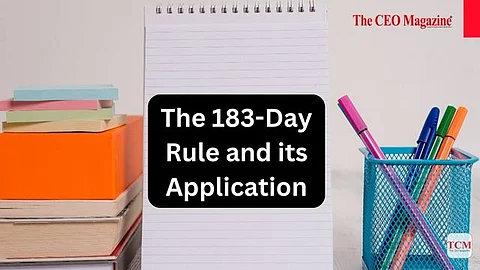

The 183-Day Rule and its Application
Understanding Tax Residency
Taxation is a complex field, especially when it comes to determining who should pay taxes and where. One of the key factors in this determination is the concept of tax residency, and a commonly used benchmark for this is the 183-day rule.
This rule, prevalent in many countries including the United States, serves as a guideline to decide if an individual should be considered a tax resident for a specific jurisdiction. Let's delve into what the 183-day rule entails, how it's applied, and its implications.
The 183-day rule is a criterion utilised by numerous countries worldwide to ascertain the tax residency status of individuals. In simple terms, if an individual spends 183 days or more in a particular country within a calendar year, they are typically considered a tax resident of that country for that year.
This rule is crucial because it signifies more than half of the year, indicating a substantial connection to the jurisdiction for tax purposes.
In the United States, the Internal Revenue Service (IRS) uses a delicate approach known as the substantial presence test to determine tax residency for non-citizens and non-permanent residents.
This test evaluates an individual's physical presence in the U.S. over a three-year period, with a particular focus on whether they've been present for 183 days during the current year and the two preceding years.
Numerous countries, including Canada, Australia, and the United Kingdom, utilise the 183-day threshold to define tax residency. However, each nation may adopt unique criteria in its application.
For instance, while some countries consider the calendar year for assessment, others may use a fiscal year. Additionally, variations exist regarding whether the day of arrival within the country counts towards the 183-day tally.
It's noteworthy that some nations have even lower thresholds for triggering tax residency. Switzerland, for instance, considers individuals tax residents if they spend more than 90 days in the country.
The IRS's substantial presence test involves a meticulous calculation. It does not merely sum up the total days spent in the U.S. Instead, it combines days of physical presence in the current year with fractions of days from the previous two years.
This calculation aims to provide a comprehensive assessment of an individual's ties to the U.S.
Moreover, the IRS has specific terms and conditions regarding days that count towards the substantial presence test.
Certain exceptions are made for individuals commuting from neighbouring countries, those in transit, crew members of foreign vessels, and individuals with medical conditions preventing departure from the U.S.
While the 183-day rule primarily applies to non-citizens and non-residents, U.S. citizens and permanent residents have their own tax obligations.
However, they may qualify for exclusions on foreign-earned income if they meet certain criteria, including physical presence tests in foreign countries and compliance with tax laws.
Furthermore, the U.S. has tax treaties with various countries to address issues like double taxation and determine jurisdiction for income tax purposes. These agreements play a crucial role in resolving conflicts of residence claims and ensuring fair taxation practices.
In addition to federal tax laws, many states in the U.S. use the 183-day rule to determine residency for state tax purposes. However, the interpretation of what constitutes a "day" can vary among states, leading to complexities in tax obligations.
For instance, time spent working in a state may influence residency status, even if an individual resides elsewhere.
In conclusion, the 183-day rule serves as a fundamental principle in determining tax residency in many countries, including the United States. While straightforward in concept, its application can be intricate due to variations in calculations and exceptions.
Understanding these intricacies is essential for individuals to fulfil their tax obligations accurately and avoid potential penalties. Moreover, consulting tax laws, treaties, and professional advice can provide valuable insights into navigating the complexities of tax residency and compliance.
Follow us on Google News
